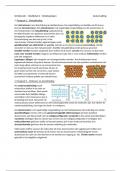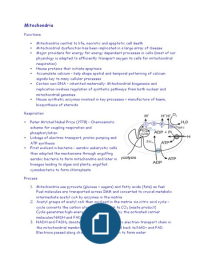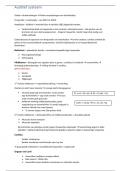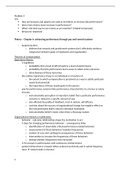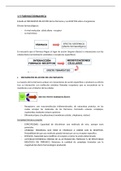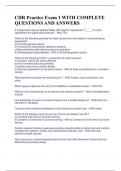INTRODUCTION TO ENDOCRINOLOGY
= study of hormones, their receptors and the intracellular signaling pathways they evoke
HORMONES
- Dynamic properties
- Ability to elicit a cascade of physiologic responses by acting on target tissues
- Chemical messengers secreted into blood or EC fluid by one cell that affect the functioning of other
cells
Endocrine Paracrine Autocrine
Hormone is distributed in blood Hormone acts locally by diffusing Hormone acts on the same cell
(can be bound to proteins) and from its source to neighbour that produced it
binds to distant target cells target cells
CHEMICAL CLASSES OF HORMONES
PEPTIDE AND PROTEIN HORMONES (INSULIN, GLUCAGON, GASTRIN…)
1) Vary in size and postTLN modification:
- Small peptides bv: vasopressin (9 AA)
- Large, multisubunit glycoproteins bv: EPO
2) Synthesis in RER
Synthesis -> large preprohormone -> RER -> cleavage of signal sequence -> prohormone -> golgi
apparatus -> packaged into secretory vesicles -> export -> active hormone
3) Secreted by 2 pathways
- Regulated secretion
= cell stores hormone in secretory granules => releases them in “bursts” when stimulated
= most commonly used pathway
= allows cells to secrete a large amount of hormone over short period of time.
- Constitutive secretion
= cell does not store hormone in secretory vesicles but secretes it from secretory vesicles
as it is synthesized.
4) Half-life = second-minutes
AMINO ACID DERIVATIVES
1) Can be from 3 AA
- Tyrosine = thyroid hormones, catecholamines ((nor)adrenalin, domapine)
- Tryptophan = serotonin, melatonin
- Glutamic acid = histamine
2) Half-life = minutes
BUT: thyroid hormones are for metabolism => concentration needs to be high during the
whole day => half-life of days
1
, STEROIDS
= derivates from cholesterol (half-life = minutes – hours)
1) Adrenal corticol hormones (corticoids)
- Mineralocorticoids (aldosterone)
- Glucocorticoids (cortisol)
2) Sex hormones
- Androgens (testosterone)
- Estrogens (estradiol)
- Progestins (pregnancy hormones, progesterone)
3) Vitamin D (7-dehydrocholesterol)
EICOSANOIDS
= polyunsaturated fatty acids derivatives
bv : arachidonic acid = precursor in membrane lipids which is released by lipases
1) Prostaglandins, prostacyclins, leukotriens, thromboxanes
2) Active only a few seconds
3) Rapidly metabolized to inactive compounds
4) Short half-life
MECHANISM OF ACTION OF HORMONES
Location of receptor Classes of hormones Mechanism of action
IC receptors (cytoplasm and Steroids Modulation of gene TXN
nucleus) Thyroid hormones
Cell surface receptors (cell Peptides – proteins Generation of second messengers
membrane) Catecholamines => alter the activity of other
Eicosanoids molecules (enzymes) within the
cell
Intracellular receptors Cell surface receptors
Ligand dependent TXN factors Hormone (first messengers) -> binds receptor -> °second
Composed of a single polypeptide chain messengers -> trigger molecular interactions -> physiological
state of cell changes
- EC domains = ligand binding domain
- Transmembrane domains = hydrophobic stretches of
amino acids to anchor the receptor in the membrane
- IC domains = effect regions = loops that react to
- DBD = binds to DNA (HREs) to induce/ repress genes hormone binding by binding to molecules => generate
- LDB => binds hormone 2nd messengers
- C terminal => recruiting coactivating factors
- N terminal => activating/ stimulating TXN by interacting
with other components of TXN machinery
- Nuclear localization sequence => targets protein to
nucleus
- Dimerization domain => 2 receptors can bind to form - Simple single pass proteins (EGFR)
heterodimers - Several subunits (IR)
1) Receptor activation: hormone binding causes - More transmembrane helices (b-AR)
conformational changes => receptor becomes able to
bind DNA
2) Receptor binds HRE in promotor regions of target genes
2
,3) TXN of the genes is affected by the hormone-receptor
complex that functions as a TF
2nd messenger Hormones Working
cAMP (nor)adrenalin
Glucagon
Luteinizing
hormone
FSH, TSH
Calcitonin
cGMP Atrial Hormone binding -> G protein active -> GC active -> GTP becomes cGMP
natriuretic -> PKG active -> target proteins are phosphorylated -> biological actions
hormone
IP3 and DAG TSH
Angiotensin
Ca2+
Conclusion: small change induced by receptor binding can lead to widespread consequences in the cell
(ANT)AGONISTS
= molecules that bind to hormone-binding sites of receptors
3
, - Agonists = molecules that bind the receptor and induce all the biological effects like the original
hormone, sometimes more or less potently
- Antagonists = molecules that bind the receptor and block binding of the agonists
IC signaling cascade will be blocked
e.g. tamoxifen binds estrogen receptor on breast tumor => blocks gene TXN
CONTROL OF ENDOCRINE ACTIVITY
Hormone concentrations too high/ low => °diseases
Precise control of concentration is crucial
1) Rate of production = synthesis and secretion is controlled: positive and
negative feedback loops
Bv: hypothalamic-pituitary axis
2) Rate of delivery = high blood flow to a target organ/cells delivers more
hormone
3) Rate of degradation and elimination = hormones are metabolized and
excreted. The action of hormone depends on its half-life
GLANDS
Small organ at the base of the brain
Pituitary
gland Complex function
Important for overall well-being
1) Anterior
= PRL, GH, ACTH, TSH, LH, FSH
2) Posterior
= oxytocin, ADH (vasopressin)
Hypothalamus Lies just above pituitary gland
Controls hormone production in pituitary through releasing hormones
- Growth hormone releasing hormone
- Thyrotropin-releasing hormone
- Cortioctropin-releasing hormone
- Gonadotropin-releasing hormone
Adrenal gland In thoracic abdomen on top of kidneys
Cortex Medulla
Glucocorticoids (cortisol) Catecholamine hormones
- Control blood sugar
- Adrenaline
- Increase burning of fat & - Noradrenaline
protein - Fight or flight respons
- Respond to fever, injury, illness
Mineralocorticoids (aldosterone)
- Control blood volume
- Regulate BP by action on
kidneys to hold H2O and Na
Sex hormones (testosterone)
- 2nd sex characteristics
4
= study of hormones, their receptors and the intracellular signaling pathways they evoke
HORMONES
- Dynamic properties
- Ability to elicit a cascade of physiologic responses by acting on target tissues
- Chemical messengers secreted into blood or EC fluid by one cell that affect the functioning of other
cells
Endocrine Paracrine Autocrine
Hormone is distributed in blood Hormone acts locally by diffusing Hormone acts on the same cell
(can be bound to proteins) and from its source to neighbour that produced it
binds to distant target cells target cells
CHEMICAL CLASSES OF HORMONES
PEPTIDE AND PROTEIN HORMONES (INSULIN, GLUCAGON, GASTRIN…)
1) Vary in size and postTLN modification:
- Small peptides bv: vasopressin (9 AA)
- Large, multisubunit glycoproteins bv: EPO
2) Synthesis in RER
Synthesis -> large preprohormone -> RER -> cleavage of signal sequence -> prohormone -> golgi
apparatus -> packaged into secretory vesicles -> export -> active hormone
3) Secreted by 2 pathways
- Regulated secretion
= cell stores hormone in secretory granules => releases them in “bursts” when stimulated
= most commonly used pathway
= allows cells to secrete a large amount of hormone over short period of time.
- Constitutive secretion
= cell does not store hormone in secretory vesicles but secretes it from secretory vesicles
as it is synthesized.
4) Half-life = second-minutes
AMINO ACID DERIVATIVES
1) Can be from 3 AA
- Tyrosine = thyroid hormones, catecholamines ((nor)adrenalin, domapine)
- Tryptophan = serotonin, melatonin
- Glutamic acid = histamine
2) Half-life = minutes
BUT: thyroid hormones are for metabolism => concentration needs to be high during the
whole day => half-life of days
1
, STEROIDS
= derivates from cholesterol (half-life = minutes – hours)
1) Adrenal corticol hormones (corticoids)
- Mineralocorticoids (aldosterone)
- Glucocorticoids (cortisol)
2) Sex hormones
- Androgens (testosterone)
- Estrogens (estradiol)
- Progestins (pregnancy hormones, progesterone)
3) Vitamin D (7-dehydrocholesterol)
EICOSANOIDS
= polyunsaturated fatty acids derivatives
bv : arachidonic acid = precursor in membrane lipids which is released by lipases
1) Prostaglandins, prostacyclins, leukotriens, thromboxanes
2) Active only a few seconds
3) Rapidly metabolized to inactive compounds
4) Short half-life
MECHANISM OF ACTION OF HORMONES
Location of receptor Classes of hormones Mechanism of action
IC receptors (cytoplasm and Steroids Modulation of gene TXN
nucleus) Thyroid hormones
Cell surface receptors (cell Peptides – proteins Generation of second messengers
membrane) Catecholamines => alter the activity of other
Eicosanoids molecules (enzymes) within the
cell
Intracellular receptors Cell surface receptors
Ligand dependent TXN factors Hormone (first messengers) -> binds receptor -> °second
Composed of a single polypeptide chain messengers -> trigger molecular interactions -> physiological
state of cell changes
- EC domains = ligand binding domain
- Transmembrane domains = hydrophobic stretches of
amino acids to anchor the receptor in the membrane
- IC domains = effect regions = loops that react to
- DBD = binds to DNA (HREs) to induce/ repress genes hormone binding by binding to molecules => generate
- LDB => binds hormone 2nd messengers
- C terminal => recruiting coactivating factors
- N terminal => activating/ stimulating TXN by interacting
with other components of TXN machinery
- Nuclear localization sequence => targets protein to
nucleus
- Dimerization domain => 2 receptors can bind to form - Simple single pass proteins (EGFR)
heterodimers - Several subunits (IR)
1) Receptor activation: hormone binding causes - More transmembrane helices (b-AR)
conformational changes => receptor becomes able to
bind DNA
2) Receptor binds HRE in promotor regions of target genes
2
,3) TXN of the genes is affected by the hormone-receptor
complex that functions as a TF
2nd messenger Hormones Working
cAMP (nor)adrenalin
Glucagon
Luteinizing
hormone
FSH, TSH
Calcitonin
cGMP Atrial Hormone binding -> G protein active -> GC active -> GTP becomes cGMP
natriuretic -> PKG active -> target proteins are phosphorylated -> biological actions
hormone
IP3 and DAG TSH
Angiotensin
Ca2+
Conclusion: small change induced by receptor binding can lead to widespread consequences in the cell
(ANT)AGONISTS
= molecules that bind to hormone-binding sites of receptors
3
, - Agonists = molecules that bind the receptor and induce all the biological effects like the original
hormone, sometimes more or less potently
- Antagonists = molecules that bind the receptor and block binding of the agonists
IC signaling cascade will be blocked
e.g. tamoxifen binds estrogen receptor on breast tumor => blocks gene TXN
CONTROL OF ENDOCRINE ACTIVITY
Hormone concentrations too high/ low => °diseases
Precise control of concentration is crucial
1) Rate of production = synthesis and secretion is controlled: positive and
negative feedback loops
Bv: hypothalamic-pituitary axis
2) Rate of delivery = high blood flow to a target organ/cells delivers more
hormone
3) Rate of degradation and elimination = hormones are metabolized and
excreted. The action of hormone depends on its half-life
GLANDS
Small organ at the base of the brain
Pituitary
gland Complex function
Important for overall well-being
1) Anterior
= PRL, GH, ACTH, TSH, LH, FSH
2) Posterior
= oxytocin, ADH (vasopressin)
Hypothalamus Lies just above pituitary gland
Controls hormone production in pituitary through releasing hormones
- Growth hormone releasing hormone
- Thyrotropin-releasing hormone
- Cortioctropin-releasing hormone
- Gonadotropin-releasing hormone
Adrenal gland In thoracic abdomen on top of kidneys
Cortex Medulla
Glucocorticoids (cortisol) Catecholamine hormones
- Control blood sugar
- Adrenaline
- Increase burning of fat & - Noradrenaline
protein - Fight or flight respons
- Respond to fever, injury, illness
Mineralocorticoids (aldosterone)
- Control blood volume
- Regulate BP by action on
kidneys to hold H2O and Na
Sex hormones (testosterone)
- 2nd sex characteristics
4

